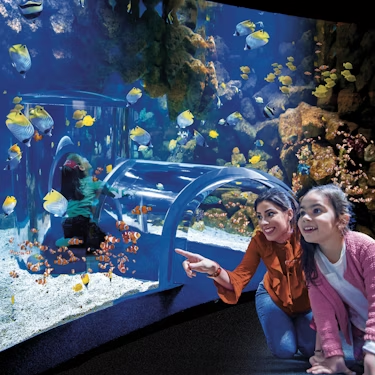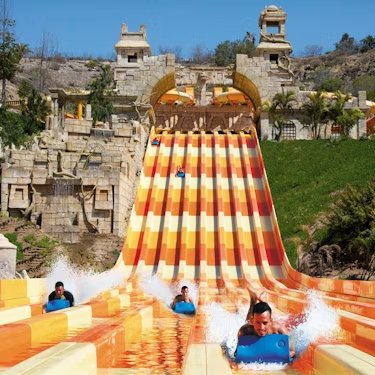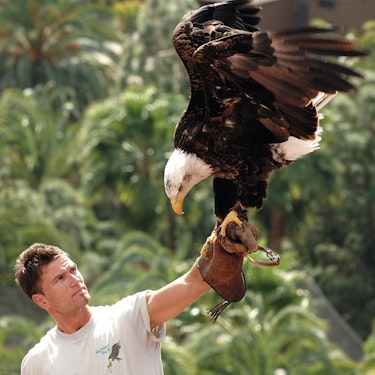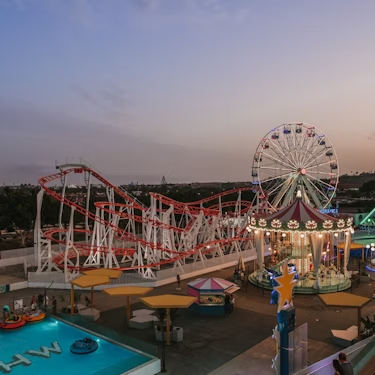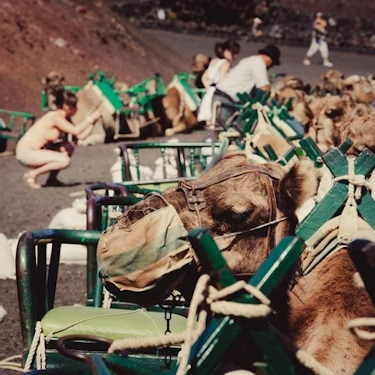More about: Gran Canaria in 7 Days: a guidebook for getting the most out of your visit
If there is one thing that sets Gran Canaria apart from other places, it is that it has attractions for everyone. Deserts, beaches, mountains and seas coexist in one of Spain's most important tourist destinations, offering visitors a complete experience. If you are planning a 7-day stay on the island, with the right itinerary you can discover the best places to visit.
Among the best things to see and do in Gran Canaria are boat trips, dolphin watching, swimming at idyllic beaches and adventure excursions.
Day 1: Tour of the historic centre of Las Palmas de Gran Canaria and visit to the Poema del Mar Aquarium

If you plan to stay in Las Palmas de Gran Canaria, then the first step is to visit the main points of interest in the city.
This will allow you to discover the historic centre of the island's capital, the most complete markets and some of the busiest beaches. You can also visit the Poema del Mar Aquarium, the largest in the Canary Islands, and enjoy the island's cuisine.
Take a tour of Vegueta, the old town of Las Palmas
The old town of Las Palmas is characterised by its colonial landscapes, its museums and its cobbled streets that hark back to the city's founding in the late 15th century.
In Vegueta , you can visit the Casa de Colón, the Plaza de Santa Ana, the Parque de San Telmo and the Cathedral, the main sights of the old town of Gran Canaria.
The winding streets of the old town are built on a slope, so I recommend that you wear comfortable shoes and bring water to stay hydrated when walking around the neighbourhood, especially in summer, as the weather can be very hot. The best time to walk around the neighbourhood is in the morning.
If you want to go shopping, you can also do so in the historic district, where you will find a large number of shops on Calle Mayor de Triana.
For lunch , you can stop at the Vegueta Market, which is not very big but has a wide variety of places to eat.
Visit the Castillo de la Luz
The Castillo de la Luz, which is currently a contemporary art refuge, is one of the most important monuments in Gran Canaria, not only because it houses the island's historical heritage, but also because during the years of the Viceroyalty of America it was a mandatory stop for the fleet of ships returning to Spain, fulfilling a vital defensive role against pirate attacks.
During visits to the Castillo de la Luz, you can see its drawbridge, the two circular towers, the control gate and the cistern in the inner courtyard. Interestingly, although it is now surrounded by land, during its construction more than six centuries ago it stood on a reef off the island.
You can get to Castillo de la Luz from the Vegueta Market by car taking the GC-1 road, by bus line 12 to the Juan Rejón stop, or by the Gran Canaria hop-on hop-off tourist buses. General admission to the castle is 4 euros.
Visit the Poema del Mar Aquarium
A few streets away from Castillo de la Luz is the Poema del Mar Aquarium, the largest in the Canary Islands and also a reserve for the island's natural fauna.
Divided into three themed exhibitions, Jungle, Reef-Beach and Deep Ocean, this aquarium has sharks, dolphins, rays, octopuses and crabs, as well as schools of fish and crocodiles.
The aquarium is a perfect alternative in Las Palmas to the best dolphin watching excursions, which usually start at the Port of Mogán or Puerto Rico Beach.
The Poema del Mar Aquarium is open every day from 9.30 am to 5 pm and general admission is approximately £25 for adults and £18 for children under 11.
The complete tour of the aquarium, including interactive experiences, will take approximately 3 hours. To end the day with a Canarian experience, you can have dinner at the Mercado del Puerto.
Day 2: Tour of Las Canteras Beach and Confital Beach and visit to the Roque Nublo Natural Monument

No tour of Las Palmas de Gran Canaria would be complete without a visit to the island's main beaches, which is where the second day's itinerary begins.
In the afternoon, after lunch, the tour continues with a half-day excursion to some of the highest points on the island and the Roque Nublo Natural Monument.
Visit Las Canteras Beach and Confital Beach
Located in the western bay of Las Palmas, Las Canteras Beach and Confital Beach are two of the main beaches in the island's capital. Confital Beach, located on the Isleta Peninsula, stands out for being a naturist beach, inclusive and with ramps for disabled people.
Confital Beach is a wild beach, so the best time to enjoy it is in the early morning. When the surfers start to arrive, it is best to move on to Las Canteras Beach, which is 10 streets away and can be reached by bus line 21.
Las Canteras Beach is the most famous beach in the city and possibly on the entire island. You will be amazed by its size and the diving tours available. Among the services on offer are a large number of restaurants, making it the ideal place to have lunch before continuing with the excursions on the second day.
Take a guided tour of the Roque Nublo Natural Monument
The interior of the island is home to some of Spain's best natural attractions, which you can discover on some of the best tours of Gran Canaria.
On these excursions, you can visit the villages of Teror and San Mateo and enjoy panoramic views from the peaks of volcanic mountains before reaching Roque Nublo.
The Roque Nublo National Monument is located in the geographical centre of Gran Canaria and is one of the symbols of the island, as it is 80 metres high, made of volcanic rock and stands at over 1,800 metres above sea level. This makes it the third highest point on the island, behind Morro de la Agujereada and Pico de las Nieves.
From Roque Nublo you can enjoy one of the clearest views of the island and if you plan to visit Gran Canaria in December
or January you can also see the sunset.
Day 3: Visit the dunes and lighthouse of Maspalomas and go on a dolphin watching excursion
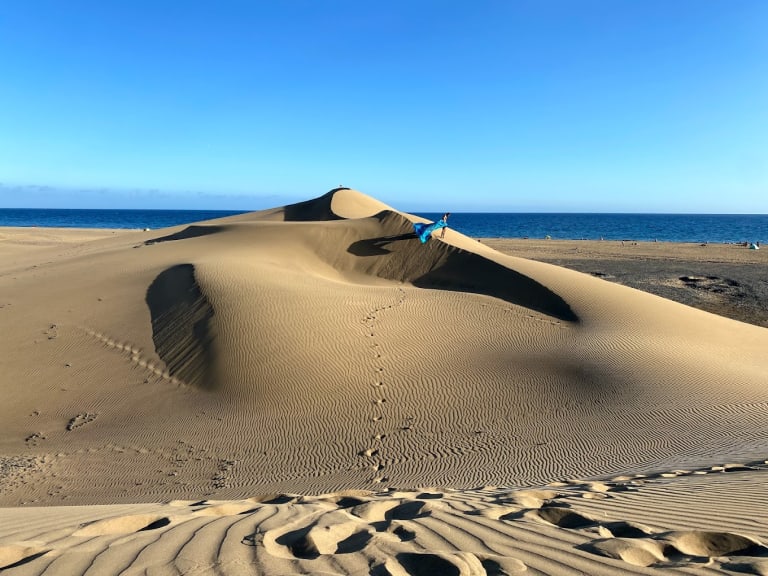
On the third day, the itinerary includes a visit to the south of the island to see the unique Maspalomas Dunes, which bear a striking resemblance to the Sahara desert landscape, and the Maspalomas Lighthouse, one of the oldest in Gran Canaria.
In the afternoon, I suggest going on a whale and dolphin watching excursion from Puerto Rico Beach.
Explore the Maspalomas Dunes
Is it possible to visit the Sahara in Gran Canaria? It seems so, at least from the Maspalomas dunes, because they offer a unique landscape that bears similarities to the desert, even sharing the climate and some of the migratory birds that also inhabit the African continent.
You can reach the Maspalomas Dunes by car from Las Palmas de Gran Canaria via the GC-1 route in a journey of about forty minutes, or by bus, combining lines L1 and 1 to the Avenida de Bonn station.
The best time to visit the dunes is in the morning, as the heat increases in the afternoon, especially in summer.
Entrance to the Natural Park is free and, once inside, for an extra cost, you can go on a camel ride through the Maspalomas dunes or take a guided tour that will take you through the best landscapes of the site, where you can take the best photographs of what is known as the great desert of the Canary Islands.
Discover the Maspalomas Lighthouse and swim at Playa del Inglés
Once you have finished your morning tour of the Maspalomas dunes, you can have lunch at one of the coastal restaurants on Playa de las Mujeres and then visit the Maspalomas Lighthouse, one of the oldest in the Canary Islands.
The Maspalomas Lighthouse is a symbol of the Canary Islands and also one of the highest points in the south of the island, along with the Mirador de las Dunas viewpoint, which you can reach from the nearby Hotel Riu Palace.
A few streets away from the lighthouse , you can visit Playa del Inglés, the most distinctive of the southern beaches, which stands out for its golden sand and calm, crystal-clear waters, as well as its enormous size.
Go on a dolphin watching excursion
A dolphin watching tour is one of the best activities you can do in Gran Canaria. From Playa del Inglés, you can reach Playa de Puerto Rico by car via the GC-1 route in about 20 minutes and hire an excursion to discover the cetaceans of the Canary Islands.
On these afternoon excursions, which last around 3 hours and start at £41, you can sail on a cruise in open waters looking for dolphins, whales and other cetaceans native to the Canary Islands, such as beaked whales and sperm whales.
During the summer or high season and when weather conditions permit, dolphin watching cruises usually make a few stops so that visitors can take a dip.
Some tourist services for boat trips in Gran Canaria also include an open bar with non-alcoholic drinks and reduced rates for children.
Day 4: Visit the Caldera de la Bandama, the Pico de las Nieves and relax in the natural pools of Agaete

If you don't think the tour has been adventurous enough so far, get ready, because the fourth day includes a visit to Pico de las Nieves, the second highest point on the island, a trip to the Bandama volcanic caldera and a relaxing swim in the pools of Agaete, on the west coast of Gran Canaria.
Visit the Bandama Caldera
The Bandama Caldera is an inactive volcanic caldera with a viewpoint from which you can see the remains of the volcano and part of the island.
The Bandama tour can be done via two trails, one of which will take you to the bottom of the crater, so if you want to take this route, it is best to start very early in the morning.
You can reach the Caldera de la Bandama by car from Las Palmas on the GC-802 road, a journey of about 20 minutes, or by bus, combining lines L1 and 311. If you opt for a guided tour of Bandama, you will learn about the volcanic origins of the Canary Islands and their relationship with the African continent.
Reach the summit of Pico de las Nieves
After Morro de la Agujereada, Pico de las Nieves, at over 1,900 metres high, is the highest point in Gran Canaria and if you reach the summit you can enjoy some of the most spectacular views of the island.
If the weather conditions are right, you can also experience the strange phenomenon whereby the winds push the clouds against the mountains and they accumulate on the cliffs, giving visitors the sensation of walking on clouds.
You can get from Caldera de la Bandama to Pico de las Nieves by car via the winding GC-15 road in just over 40 minutes. You can reach the summit by car or hire a hiking tour with an expert local guide.
Relax in the natural pools of Agaete
If you want to rest your legs after the exhausting tour of the Caldera de la Bandama and Pico de las Nieves, you can visit Las Salinas.
Las Salinas consists of three pools in the rocks that provide shelter from the strong waves and also create a relaxing space from which, on clear days, you can glimpse the Pico del Teide on the neighbouring island of Tenerife.
Las Salinas de Agaete can be reached by car from Pico de las Nieves via the GC-150 route in just over an hour.
Day 5: Visit Gáldar and Sardina del Norte Beach

On the fifth day, after an adventurous tour, I suggest visiting Gáldar, the colonial village in the north of Gran Canaria that was the island's first capital and still retains its ancient architecture.
Afterwards, you will head to Sardina del Norte Beach, a paradise of crystal-clear waters flanked by cliffs and seafood restaurants.
Explore Gáldar, the island's first capital
If you liked the old town of Las Palmas de Gran Canaria, you'll also be drawn to Gáldar, a village in the north of the island that still retains its pre-Hispanic architectural heritage and a wealth of colonial attractions.
In Gáldar, you can visit the parish church of Santiago, the Consistorial Theatre, La Recova Market and the Cueva Pintada Archaeological Park, one of the largest sites of rock art in the Canary Islands. The Cueva Pintada is one of the most interesting attractions on the island and can be visited free of charge at weekends.
You can get to Gáldar from Las Palmas de Gran Canaria by car on the GC-3 road, a journey of just over half an hour, or by public transport, combining bus routes 1 and 105.
Visit Sardina del Norte Beach
In Gáldar, Sardina del Norte Beach is a lost paradise in a coastal village that has everything you could possibly want. On the spectacular beaches, you can go diving, rent kayaks, fish, practise water sports and try the most delicious local food with views of the sea.
Sardina del Norte is one of the most beautiful beaches in Gran Canaria and stands out for its crystal-clear blue waters and the cliff walls that flank the beach. It is an ideal place to have lunch after exploring the historic centre of the town and to spend the afternoon waiting for the sunset.
You can reach Sardina del Norte Beach by car in just over 10 minutes or hire one of the local private transport services, as there are no regular buses on this route.
Day 6: Take a full-day adventure tour of the north of the island

If you enjoyed Gáldar and the beaches of northern Gran Canaria, as well as the adventure tours of the island's interior, I suggest a full-day excursion to the ancient forest of Doramas on your sixth day.
Join The Rainforest Tour, a full-day jungle tour
With these excursions, which include round-trip transport and hotel pick-up, you can visit the Barranco de Azuaje, which is the gateway to the ancient Selva de Doramas forest in Gran Canaria. In this natural setting, you will discover the Laurisilva Forest and take your first walk of the day along the riverbed.
During the tour , you will also visit the Azuaje Viewpoint, one of the most beautiful on the island, and you can take a dip in some of the natural pools in the ravine.
These adventure tours will immerse you in the exotic green trails of northern Gran Canaria, which still preserves some unspoilt areas, and you will learn about the history of the local indigenous peoples and the pre-Hispanic inhabitants of the Canary Islands.
These tours usually include entrance fees to attractions, tastings, local guide assistance and transfers in the reference price, which has an approximate initial cost of £71 per person.
Day 7: Discover the villages of Agüimes and Telde and visit the Los Lirios Winery

On the seventh and final day, the itinerary includes a tour of two of the most picturesque villages in Gran Canaria and a tour of the Bodega Los Lirios, one of the island's leading wine producers since its foundation.
Visit Telde and Agüimes, two of the most picturesque villages on the island
Telde is the second most populated city in Gran Canaria, but it is also a beautiful place that preserves some of the architectural gems of its pre-Hispanic past, such as the Basilica of San Juan Bautista and the Casino.
In Telde you can also visit the Cueva de Cuatro Puertas cave and the idyllic Tufia beach.
Telde can be reached by car from Las Palmas via the GC-3 road in just over 10 minutes and by public transport by bus, combining lines 54 and 12. On the outskirts of the town, you can also visit the Corredor Paisajístico, an ideal place for hiking and cycling.
Twenty kilometres from Telde, on the GC-1 road, you can reach Agüimes by car . Although slightly smaller, it is also notable for its parish church, the Plaza del Rosario and the Bahía de Formas, which is why they are considered sister towns.
End your visit to Gran Canaria with a tour of the Los Lirios Winery
Bodega Los Lirios is one of the most traditional wineries in Gran Canaria and also a must-see for anyone visiting the island.
Located in Los Lirios, very close to the Cuesta de los Alvarados, this winery and vineyard is an ideal way to end your tour of the Canary Islands with a wine and cheese tasting.
You can reach Bodega Los Lirios by car from Agüimes via the GC-1 road and take an afternoon excursion of about 3 hours to taste red wine from their vineyard and try local products while you wait for the sunset and plan, why not, a second trip to Gran Canaria.
Summary of your itinerary in Gran Canaria
- Day 1
- Historic centre of Las Palmas
- Vegueta Market
- Castillo de la Luz
- Poema del Mar Aquarium
- Day
- Las Canteras Beach
- Confital Beach
- Roque Nublo Monument
- Teror and San Mateo
- Day
- Maspalomas Dunes
- Maspalomas Lighthouse
- Puerto Rico Beach
- Dolphin watching
- Day
- Bandama Caldera
- Pico de las Nieves
- Las Salinas
- Agaete
- Day 5
- Gáldar
- Painted Cave
- Sardina del Norte Beach
- La Recova Market
- Day
- Doramas Forest
- Azuaje Ravine
- Azuaje Viewpoint
- Laurisilva Forest
- Day
- Telde
- Aguimes
- Cuatro Puertas Cave
- Los Lirios Winery

